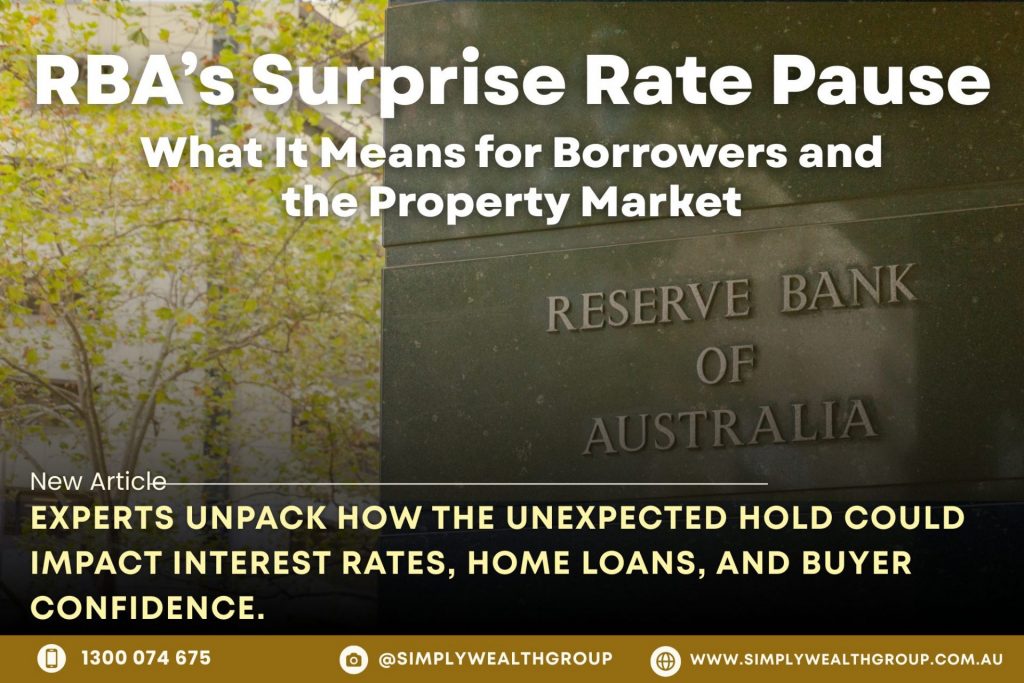RBA’s Surprise Rate Pause:
What it means for Borrowers and Property Market
In a move that caught both markets and analysts off guard, the Reserve Bank of Australia (RBA) decided to hold the official cash rate (OCR) steady at 3.85% during its July 2025 policy meeting. This decision, which diverged sharply from the widely expected rate cut, has sent ripples through the financial sector, property market, and broader economy. This comprehensive article explores the context behind the RBA’s decision, the immediate and long-term reactions from key stakeholders, and what this means for Australian households, businesses, and investors in the months ahead.
Setting the Scene: Economic Backdrop
Mixed Economic Signals
- Inflation: Eased to a three-year low and now sits within the RBA’s target range.
- Unemployment: Remains historically low, signaling labor market strength.
- Cost-of-Living: Pressures persist, squeezing household budgets.
- Global Uncertainty: Ongoing trade tensions, new US tariffs, and geopolitical risks continue to cloud the outlook.
Expectations vs. Reality
All of Australia’s Big Four banks and most market analysts had forecast another rate cut, with markets pricing in a 25-basis-point reduction. The RBA’s decision to pause was a sharp deviation, attributed to lingering global uncertainty and a desire for more information before further action.
The RBA’s Rationale
Why the Pause?
- Global Uncertainty: The RBA cited international risks, particularly the unknown effects of new US tariffs and global economic headwinds.
- Inflation Data: Although inflation has eased, the RBA wants to ensure it remains sustainably within target.
- Wait-and-See: A cautious approach allows the RBA to gather more data before committing to further easing.
Board Dynamics
The decision was not unanimous, with a 6-3 vote in favor of holding rates. This split reflects the complexity of the current economic environment and the difficulty of balancing domestic needs with global risks.
Immediate Market Reactions
Financial Markets
- Currency: The Australian dollar jumped on the news, reflecting surprise and a reassessment of rate expectations.
- Bond Yields: Rose as investors recalibrated their outlook for future rate cuts.
- Equities: The stock market showed a muted reaction, with investors focusing on upcoming economic data and global developments.
Property Market
- House Prices: National prices have risen 3.2% since the start of 2025, with the rate pause unlikely to alleviate demand-side pressure. Perth, Melbourne, and Sydney are leading the gains.
- Investor Activity: Remains strong, with 30% of new loans in June going to investors—the highest in three years.
Voices from the Industry
Mortgage Brokers and Lenders
- Disappointment Among Borrowers: Many were hoping for relief via another rate cut to ease mortgage payments.
- Shift Toward Variable Rates: Demand for fixed-rate home loans has plummeted, with only 1% of June submissions having a fixed component.
- Investor Confidence: The current environment is fueling investor activity, as rising rents and tight supply make property investment attractive.
Industry Associations
- MFAA: The Mortgage & Finance Association of Australia noted the shock among borrowers and highlighted opportunities for brokers to help clients reprice, refinance, or consolidate debt.
- Connective: Emphasized that borrower expectations remain high, with many actively reviewing their loans and anticipating future rate cuts.
Business Community
- CPA Australia: Small businesses remain cautious, with many hoping for lower rates to spur investment and ease debt burdens. The current pause is seen as a missed opportunity to boost business sentiment and growth.
Economists
- REA Group: Warned that the rate hold may slow the pace of property price growth, but affordability constraints remain a major concern for households.
- Oxford Economics Australia: Suggested the RBA should have acted, preferring to build economic momentum ahead of potential challenges.
- BDO Economics: Predicted that the restrictive cash rate would slow economic growth, expecting further cuts by the end of 2026.
Government and Policy Response
- Federal Treasurer: Acknowledged widespread disappointment but reiterated the RBA’s independence in making monetary policy decisions.
- Regulatory Suggestions: Some industry leaders called for a reduction in the mortgage serviceability buffer from 3% to 2.5% to increase borrowing capacity without fueling inflation.
Impact on Households
Borrowers
- Affordability Pressures: Many households are struggling with stretched budgets as mortgage repayments remain high.
- Refinancing Opportunities: Homeowners are encouraged to compare rates and consider switching lenders, with cashback offers providing additional incentives.
- Expectation Management: While the pause was disappointing, most forecasters still anticipate further cuts before year-end.
First-Home Buyers
- Barriers to Entry: High prices and tight lending standards continue to make homeownership challenging, especially in major cities.
- Shift to Alternatives: Many are exploring units, townhouses, or more affordable regions.
Impact on Businesses
- Sentiment: Business confidence has improved, with the NAB Business Confidence Index rising to its highest level since January.
- Investment Decisions: Many small businesses remain cautious, holding off on expansion or hiring until monetary policy becomes more supportive.
- Debt Management: Lower rates would have provided more flexibility for renegotiating loans and reducing debt burdens.
The Broader Economic Outlook
Inflation and Growth
- Inflation: Now within target, but the RBA remains wary of premature easing.
- Economic Growth: Weaker than anticipated, with risks from global trade tensions and domestic affordability constraints.
Future Rate Path
- Market Expectations: Markets are still pricing in up to three rate cuts before the end of the year, suggesting the pause may be temporary.
- Bank Forecasts: Major banks expect the cash rate to settle between 3.1% and 3.35% by year-end, with Westpac the most dovish, projecting a bottom of 2.85%.
Housing Market: Winners and Losers
| Stakeholder | Impact of RBA Pause |
| Existing Homeowners | Continued equity gains, but higher mortgage repayments |
| First-Home Buyers | Affordability challenges persist, entry barriers remain |
| Investors | Strong rental yields, increased investor loan activity |
| Renters | Ongoing rental shortages, rising rents |
| Small Businesses | Cautious sentiment, limited scope for debt reduction |
Key Takeaways and Practical Advice
For Borrowers
- Review Your Loan: Compare your current rate with market-leading offers and consider refinancing.
- Stay Informed: Monitor RBA decisions and economic data for signs of future rate cuts.
- Budget Wisely: Plan for continued cost-of-living pressures and avoid overextending financially.
For Investors
- Focus on Yield: Target areas with tight rental markets and strong population growth.
- Monitor Policy: Stay abreast of regulatory changes that could impact borrowing capacity or investment returns.
For Businesses
- Maintain Flexibility: Prepare for continued uncertainty by managing cash flow and debt prudently.
- Look for Opportunities: Be ready to invest when conditions become more favorable.
Frequently Asked Questions
Why did the RBA pause instead of cutting rates?
The RBA cited global economic uncertainty, particularly around new US tariffs and the need for more data to confirm inflation is sustainably within target.
Will rates be cut later this year?
Most market analysts and banks still expect further rate cuts before year-end, with the next key data points and policy meetings closely watched.
How does the pause affect house prices?
While the decision may slow the pace of recent price growth, underlying demand and supply constraints mean prices are likely to remain elevated, especially in major cities.
Conclusion
The RBA’s surprise decision to hold the cash rate steady at 3.85% has triggered a wave of reactions across Australia’s financial markets, property sector, and business community. While the pause reflects a cautious approach amid global uncertainty, it has left borrowers and businesses hoping for relief disappointed. Nevertheless, the consensus remains that further rate cuts are likely before year-end, as the RBA seeks to balance inflation control with the need to support economic growth.
For households, businesses, and investors, the coming months will require careful monitoring of economic indicators, policy developments, and market trends. Staying informed and adaptable will be key to navigating this period of uncertainty and opportunity.
- https://www.brokernews.com.au/news/breaking-news/the-market-reacts-to-the-rbas-surprise-rate-pause-287530.aspx
- https://www.mpamag.com/au/mortgage-industry/market-updates/rba-blindsides-market-with-interest-rate-pause/541726
- https://www.theurbandeveloper.com/articles/rba-rate-hold-july-industry-reacts
- https://www.morningstar.com.au/markets/market-minute-new-tariffs-announced-bond-market-movement-surprise-rba-rate-hold-2
- https://www.bloomberg.com/news/articles/2025-07-08/australia-unexpectedly-holds-key-rate-steady-currency-jumps








